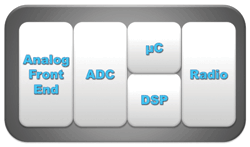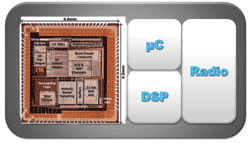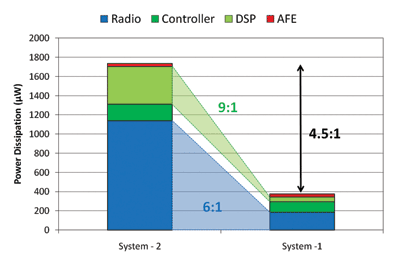Low-power ASIC paves way to autonomous sensor nodes
Sensor nodes for monitoring body parameters promise to be almost unnoticeable to the wearer
BY REFET FIRAT YAZICIOGLU and ELS PARTON
IMEC, Leuven, Belgium
http://www.imec.org
The wearable trend has changed our lives dramatically. Although we are not aware of it most of the time, we carry around a wearable computer, a wearable telephone and some of us even a wearable juke-box in the form of an mp3 player. Tomorrow, we will also be accompanied by our wearable doctor and fitness coach.
A wearable health coach
The current healthcare system is characterized by curative care and hospitalization of the patient. Everyone agrees that this is an expensive model which will be subjected to great pressure with the aging population and the rise of chronic diseases in western countries. An alternative model is predictive medicine where patients are monitored continuously and problems are signaled in an early stage (see Fig. 1 ).
To achieve continuous monitoring, small sensors can be integrated on and in our body without interfering in our daily lives. Patients with blood pressure problems can wear sensors to monitor blood pressure and heart activity. The data can be collected 24 hours a day, 7 days a week, which allows the physician to interpret the problem very precisely — is it stress-related, work-related, activity related — and to correlate changes in health with changes in diet, sports or other lifestyle factors. And, a warning can be sent to the physician or hospital if alarming values are reached.


Fig. 1. Wearable health sensors allow to continuously monitor specific parameters without interfering the patient’s daily routine. Here, an ECG necklace is shown.
Challenges: size, autonomy, and motion artifacts
In order to bring this wearable health coach vision to reality, many hurdles have to be handled (see Fig. 2 ). An obvious one is miniaturization: wearable means light weight and small. Another requirement is autonomy: we don’t want to change batteries every day, so low power is imperative – ideally to a level where energy scavenging can fulfill the need. Thirdly, reliability is key. We don’t want the ambulance at our door due to false measurements. Since the sensors will be worn during normal daily activity, motion artifacts must be understood by the system.
Today, miniaturization of sensor systems is very advanced. Systems of only 1 cm3 are possible and bendable IC packages promise to add even more comfort to the patient. Power consumption however is still a huge challenge with the DSP and the wireless radio link as the main guilty parties

Fig. 2. The main building blocks of a wearable sensor system.
Analog signal processor tackles motion artifacts
As a parallel track to low-power DSP and radio research, the research institute imec/Holst Centre has developed an analog signal processor (ASP) ASIC (see Fig. 3 ) that reduces the sensor system’s power consumption by a factor of five. The ASIC was integrated into a portable and wireless ECG monitoring system where (1) it performs low-power signal acquisition for ECG signals; (2) it can be used as a companion ASIC to DSP platforms to further reduce their processing load for low-power processing solutions; (3) it address the data overload problem and proposes a compressive sampling scheme for reducing the wireless transmission power; (4) it proposes a method to monitor the signal integrity of remote biopotential monitoring applications to ensure the validity of the signal.

Fig. 3. The analog signal processor ASIC reduces system power consumption.
Low-power signal acquisition
The power optimization of the ASIC focused on a low-power and high-performance instrumentation amplifier implementation. The main target here was to maintain the existing power efficiency of the analog front-end while trying to perform more than just signal acquisition.
High performance is also required due to the fact that ECG signals (see Fig. 4 ) have low-frequency content and small amplitudes. In a standard instrumentation amplifier, flicker noise dominates at low-frequencies. On the other hand, ECG signal measurements generally suffer from 50/60 Hz interference from mains that requires high CMRR. For all these reasons, a chopper stabilized IA was used since this architecture can eliminate flicker noise and has a high CMRR with very low power. Multiple signal paths are implemented in the ASIC: one channel for ECG monitoring, two channels for assisting DSP, and two channels for signal integrity monitoring. A single IA was designed in which these input stages were combined, resulting in significant power reduction.
Low-power processing
One of the key requirements for the ECG monitoring applications is the robust and precise detection of the R peak. This is generally achieved by first detecting the QRS complex and searching for the R peak within the QRS complex. Traditional solutions tackle ECG signal processing in the DSP domain leading to high DSP power. Therefore, the question is whether it is possible to shift this feature extraction to the analog domain.

Fig. 4. The ECG signal.
It has been shown in literature that heterodyne chopping can be implemented in the analog domain, extracting signal fluctuations in a specific frequency band in a power efficient manner.
In the imec/Holst Centre implementation, band-power extraction was used to detect the QRS complex of ECG signals where the signal fluctuations in the bandwidth of the QRS complex and the time domain ECG signal are extracted.
Using this platform, the band-power of the ECG signal is extracted within the frequency band of the QRS complex and used as a feature for beat detection algorithm. Using this implementation, the QRS complex can be detected with high sensitivity. Moreover, the power dissipation of this digital platform is reduced by an order of magnitude (see Fig. 5 ).
Minimizing data rate
Continuously transmitting ECG signals creates a significant data overload which increases the radio power dissipation. Obviously, processing signals prior to the wireless transmission can minimize the amount of data sent, however, the doctor still wants to see the time domain ECG signal. For this reason, compression is a good solution, not disturbing the information content of the signal.
An adaptive sampling approach based on activity-based sampling ADCs is implemented. This allows use of conventional A/Ds while adapting the sampling rate of the ADC according to the frequency content of the signal. The measurement results from the activity based sampling show that the radio power is reduced by a factor six at the lowest duty cycle setting as compared to an ECG signal that is constantly sampled at 1024 Hz (see Fig. 5).

Fig. 5. The analog signal processor reduces the power consumption of the DSP and wireless transmission by 9 and 6 times, respectively.
Monitoring signal integrity
It is important to ensure the reliability of ECG signals during remote patient monitoring. However, this is a significant problem in ambulatory recordings due to the presence of motion artifacts. For example, in ECG monitoring, motion artifacts may look very similar to the ECG signals and hence significantly reduce the reliability of beat detection algorithms.
The change of the electrode-tissue impedance can have high correlation with motion artifacts and thus has the potential to be used to monitor the presence of motion artifacts. However, the impedance must be measured without disturbing the ECG signal and in a low-power manner. The ASP ASIC uses an implementation in which the electrode-tissue interface is stimulated by two ac currents. The ac current sources use chopper-stabilization at twice the frequency of the ac currents and sets the mean value of the stimulation current to zero. The resulting ac voltage over the electrode-tissue interface is only demodulated by the CT impedance-monitoring channels. This enables the separation of ECG and impedance signals in the frequency domain by using a low-pass filter. Therefore, signal band-power, ECG signal, and electrode-tissue impedance can be monitored simultaneously with low-power dissipation. ■
Advertisement
Learn more about Imec





